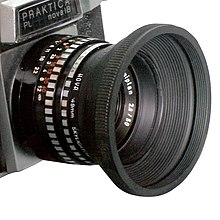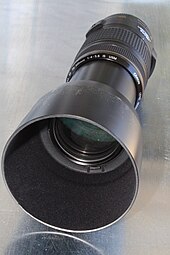Lens hood

The lens hood (other common names: sun visor , lens hood , lens shade ) is an accessory in the photograph and a component of telescopes or reflecting telescopes in astronomy .
function
A lens hood is intended to prevent laterally incident light from being reflected on lenses or mount parts and thus reaching the image sensor or film or also into the eyepiece . This can lead to considerable impairment of the image, for example through optical overlays in the form of light fringes in the shape of the lenses, i.e. usually circles or rings - the so-called lens flares . Furthermore, the image of the photographed or observed object becomes dull and low in contrast due to such scattered light .
In practice, the lens hood also offers a certain amount of protection for the front lens, for example in the event of rain, spray or against contact and light impacts.
The lens hood has no effect when taking pictures with direct backlight such as sunsets . The formation of ghost spots or other reflections caused by light sources within the image field cannot naturally be prevented by a lens hood.
Executions
In photography there are suitable lens hoods for almost all commercially available photo lenses as separate accessories in the form of rigid tubes made of metal or plastic as well as foldable rubber covers. The assembly takes place by means of a separate screw thread, bayonet connection, by pushing on and also by screwing into the filter thread. Zoom and telephoto lenses are partly equipped with extendable lens hoods. In the case of lenses with a particularly short focal length, the lens hood is sometimes an integral part of the lens barrel and is therefore inseparable.
In the case of compact cameras, in particular with zoom lenses recessed in the rest position, the installation of a lens hood is usually only possible with special accessories or not at all. In cameras with an optical see-through viewfinder, it is possible that the lens hood partially obscures the viewfinder image. With all cameras there may also be shadowing when using integrated flash units.
interpretation
The optimal geometry of the lens hood depends on the angle of view of the lens, the diameter of the front lens and the size of the sensor or film surface. A lens with a small angle of view usually has a longer lens hood than a lens with a large angle of view. Lens hoods for zoom lenses are always designed for the shortest focal length (largest angle of view) and for the largest possible sensor or the usable image circle of the lens. The use of lenses designed for the 35mm format on cameras with smaller image sensors, for example in the APS-H or APS-C format, however, usually enables the use of larger lens hoods with a better effect than intended by the lens manufacturer.
The wrong choice of lens hood either leads to a reduced protective effect if it is too short or to vignetting if it is too long or too small in diameter. When using additional filters , screw-in bezels can cause further vignetting, especially with wide-angle lenses.
If the hood attachment or the front lens do not rotate when focusing or zooming, the lens hood can be made a little longer. Since vignetting occurs first in the corners, these are then left out (tulip shape). The advantage of this construction is the slightly better protection against stray light with longer focal lengths.
The compendium is a special form of the lens hood . This is an attachment, usually in the form of an adjustable bellows , which is common with film or view cameras . A compendium can be optimally adjusted to lenses with different angles of view . Most compendia also have holders for photographic filters or other accessories.
A new type of compendium was invented by Roger Field and produced by the Chrosziel company, with a rigid plastic housing and an internal, axially adjustable mask for lenses with different focal lengths.
astronomy
There are three types of lens hoods in astronomy:
- A diaphragm located in front of the lens or in front of the opening of the telescope is called a dew cap . On the one hand, this has the same function as the lens hood in photography. But it should also protect against moisture at night. This is why it can be heated in more complex telescopes.
- In the tube of lens telescopes there are flat apertures at certain intervals, the outer diameter of which adapts to the tube and the inner diameter of which just allows the beam path to pass through.
- Glare tubes are used inside reflector telescopes .
Individual evidence
Web links
- Lens hood in olypedia.de ( page no longer available )
- Database for Canon lens hoods taking into account the sensor size
- lenshoods.co.uk ("Free printable cardboard lens hoods")




